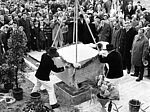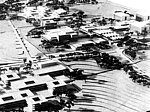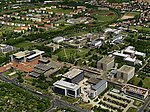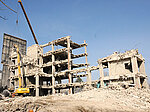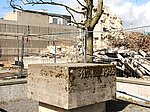Campus Hubland
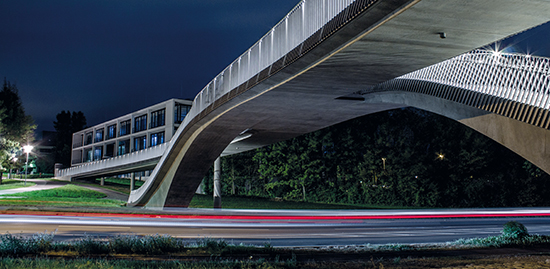
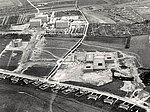
A new campus on the outskirts
11 May 1965 is an occasion to celebrate for the University of Würzburg. It is the day of the cornerstone ceremony of Hubland Campus. But the move to the periphery had long been controversial.
11 May 1965: The Julius-Maximilians-Universität Würzburg (JMU) celebrates its 383rd foundation ceremony. Principal Wilhelm Arnold delivers a speech about "person and culpability". After his "highly interesting address" – as the Main-Post daily will report on the next day – the university presents the "Bene merenti" medal in gold to Würzburg's mayor, Dr. Helmuth Zimmerer. Business as usual so to speak in the Schönborn Hall of Mainfränkisches Museum.
But something is still different on this day: After the festive ceremony, the party does not meet for a pleasant get-together. Instead, the dignitaries and guests head for the eastern periphery of Würzburg to attend another highlight on the agenda: the ceremonial laying of the foundation stone for the extension premises of the university – dedicated to the new building of the Institute of Organic Chemistry on the new Hubland Campus.
A happy day for the Bavarian people
"This institute is the first construction project of the planned centre of chemistry set to be joined by four other scientific centres in the next years," as the Main-Post quotes undersecretary Erwin Lauterbach on the next day. During the festive ceremony, the latter refers to the event as a "happy day for the Bavarian government and the Bavarian people", pointing out that the university has caught up with other German universities despite the massive destructions of 16 March 1945.
Würzburg daily papers from 11 May, a special supplement of the Main-Post titled "20 Jahre danach" (20 years after) from 8 May 1965 and currently circulating coins are put in a copper time capsule that is fitted into the 2.5 tonne cornerstone. Subsequently, a crane lowers the stone on the prepared foundation, giving the starting signal for the JMU's extension on the Hubland Campus. The step of moving to the periphery was preceded by a lengthy and acrimonious discussion.
Shortage of space in the city
In the early 1960ies, lack of space is the major issue at the university. In the summer term of 1957, only 2,935 students are enrolled which increases to about 4,800 three years later to surpass the mark of 7,000 in the summer of 1965. The number is expected to rise to about 10,000 over the next years. Too much for the buildings in the city centre which basically comprise the Old University on Domerschulstraße, the New University on Sanderring, then still without the fourth wing at the back, and the buildings on Röntgenring.
No wonder that the newly elected principal, Joseph Ziegler, announces in 1961 already: "Our university has long become too small. The acute shortage of space therefore causes us the greatest concerns for the near future." According to Ziegler, not only students are affected by the cramped situation; the university did not know at the time how to adequately quarter 17 newly appointed professors and staff. In an interview with the Main-Post, Ziegler hence spoke in favour of a "totally new university on the periphery" which would provide sufficient capacity for the next decades. The principal, comparable to today's university president, even wanted to create living space for students and professors on the campus. Only the university library, which was located in the Old University at the time, was to be left in the city centre "to accommodate the older people and emeritus professors", though in a different location. Ziegler believes that the orangery in the Court Garden is the "ideal place" for this.
Difficult search for suitable sites
The university committees, too, are discussing a solution for the space problem on a regular basis. On 22 February 1961, Professor Walter Sax, director of the administrative committee, repeats his discussions with city representatives regarding the municipal development plan during a senate meeting. During these talks, the university had claimed a number of plots for its purposes, including a huge area on Oberdürrbacher Straße, in the Court Garden between orangery and court jail and around 50 hectares at the eastern periphery.
Initially, the extension on the periphery had little support from the members of the senate. At their meeting on 8 November 1961, its members decide to go to every possible length to acquire property for the extension of the university in the inner city area "in order to preserve the tradition of the university's central location which is also relevant in an intellectual sense" as the minutes put it.
Clear decision in favour of peripheral extension
But the tables were to turn already on 24 January 1962. Principal Joseph Ziegler presses for a quick decision, because a meeting in the Ministry of Finances about the university extension is scheduled two days later. Without this decision, he believes that it will be impossible to persuade the Ministry of Finance to purchase the property. For the representatives of the Medical and Scientific Faculty, the case is clear: The university must seize the opportunity to get hold of the Hubland site. Also, they claim that the new premises should be as large as possible in order to accommodate more faculties besides the Faculty of Natural Science. The dean of the Faculty of Philosophy agrees to this proposal: "As his faculty's space requirements are not only very urgent but also quite substantial, they decided in favour of the Hubland project," according to the minutes.
Only the dean of the Faculty of Law and Political Science voices his concerns: He points out that the approval to purchase the Hubland plot should not be binding in terms of moving the entire university in the future.
The subsequent vote is unanimous and provides for the university management to work towards "immediately acquiring land in the largest extent for the purposes of the university to be able to plan both generously and in the long term". At the same time, "this should not under any circumstances hinder the corresponding construction work to remedy the shortage of space in the city centre".
Fear of a satellite city
However, this does not put an end to the discussions about the university's future course. It is kindled by a full-page article in the Main-Post in 1962. On June 22, the newspaper publishes an article titled "Alma Julia – quo vadis?" which covers the university's intention to "move a considerable part of its institutes to the periphery, yes even outside the city limits". The author under the pseudonym "Kolonat" frankly offers his opinion. He complains that the "spatial division" would amount to an alarming loss of substance; the move would be an "effective separation". The extension to the Hubland premises "up there at and outside the city limits would result in an academic satellite city with its own residential area for students, its own shopping and conference centres, its own housing for lectures" – short: "a satellite town that would require bus services to stay connected to the actual city of Würzburg."
A plea to stay in the city
During the next meeting after the article has been published, the members of the senate briefly but unsuccessfully look for the "whistleblower" who might have disclosed the sensitive information to the Main-Post editor. Subsequently, principal Erich Carell seizes the opportunity to advocate that the university should stay in the city. He advises against taking the easy road by saying that there are no suitable properties up for purchase in the neighbourhood of the university. He believes that if only enough money is offered, surely something will turn up. This leads to an "animated discussion as to what else would have been possible, could have happened or done", as the minutes pointedly note.
Nevertheless, this meeting comes to the same conclusion: The senate argues that all preconditions should be created to allow the Faculties of Natural Science and Philosophy to remedy their shortage of space as needed on the property to be acquired on the outskirts.
The cabinet approves the extension plans
A year later, the moment has finally come: On 10 July 1963, the principal tells the members of the senate that the cabinet has decided to relocate parts of the university to the Hubland area. The decision states "that the Faculty of Natural Sciences as a whole is to be moved to these premises in several stages." Additionally, the institutions of the Faculty of Philosophy will be moved to the city outskirts. This is the only way to relieve the faculties quickly and efficiently and to provide space for future development.
The next 18 months see plenty of action: The Free State of Bavaria purchases the required land in the Hubland area, the construction plans for the buildings of the Faculties of Natural Sciences and Philosophy are pushed on. The university representatives are now pressing ahead. For a reason: On 10 July 1962, the Bavarian state parliament had decided the founding of a fourth state university in Regensburg. Würzburg fears that the new buildings on the Danube could slow down the development on the Main river.
Cornerstone laid during the foundation ceremony
Luckily, this is not the case. In a meeting of the senate on 27 January 1965, principal Wilhelm Arnold gives account of a conversation with undersecretary Dr. Franz Lippert in the Ministry of Finance. The latter has confirmed that all pertinent ministries in Munich have come to the conclusion that the construction plans of the Faculty of Natural Sciences should be implemented as quickly as possible as well as the Faculty of Philosophy's wish to build a seminar and lecture room building in the near future. The reactions of the members of the senate are described as follows in the minutes:
"The administrative director asks to speak and suggests to lay the cornerstone in a festive act during the planned foundation ceremony in the presence of top state authorities to show the public that progress is being made. The senate agrees to this."
Gunnar Bartsch
Since then, the University of Würzburg has had many occasions to celebrate cornerstone laying festivities, topping out ceremonies and inaugurations. Today, it accommodates the central building of the university library, the cafeteria, the buildings of the Faculty for Chemistry and Pharmacy, the Biocenter, the Institute of Physics, Computer Sciences, the computing centre, the Geography department, the Philosophy building, part of the Sports Centre and a central lecture room and seminar building.
But that's not all: In 2011, the university spread to an adjacent plot of land: the Hubland North Campus. The 45 hectare area had previously been occupied by US forces. Today, it is home to additional institute buildings, laboratories, seminar rooms and extension spaces for the University of Würzburg.






